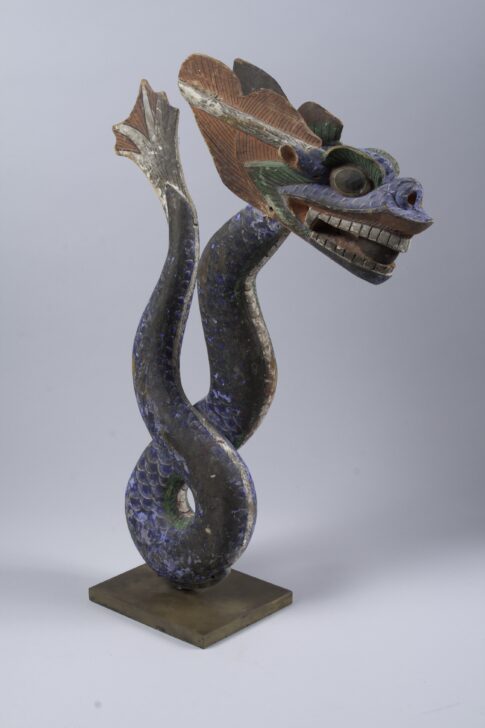Dragon-shaped Ornament for Funeral Bier
Korean

Description
These ornaments were once attached to a funeral bier (the platform used
to transport a coffin to a burial place). In Korea the funeral ceremony was
considered the start of a journey for the departed. The funeral bier was
decorated with colorful wooden ornaments embodying wishes for a peaceful
afterlife for the deceased and good fortune for descendants. Figures included
a guide to lead the deceased into the other world, a guard to protect against
evil spirits, a caregiver, and an entertainer to console the dead and mourners.
Protective dragons and phoenixes were affixed to the front, back, and top of
the bier. Here the dragon has the body of a snake, so it may be an imugi, a
benevolent creature that is not yet a full dragon. It holds a cintamani
(wish-fulfilling jewel) in its jaws.
Before they became popular among foreign collectors in the 1970s, objects
related to religious and funerary rites were taboo in Korea and people feared
being close to or handling them. Though many mass-produced versions were
made after the 1970s, these rare ornaments were created around 1900.
Fall 2015 Gallery Rotation
Subject Matter:
An ornament for a funeral bier in the shape of an eastern-style dragon with no arms or legs. Due to the lack of appendages, it is possible that the dragon is an imugi, which is a Korean mythological creature that has yet to attain the state of being a full dragon. Grasped within its jaw is a cintamani, known as a wish-fulfilling jewel.
These creatures were considered to be benevolent and resided in bodies of water.
Physical Description:
A blue serpentine figure with no arms or legs. The body curves and bends over itself so that one coil is attached to the wooden base. The blue scales are highlighted with white. The head and tale also contain orange and green paints. The entire object is coated with a white substance which was then painted over. The head shows signs of restoration with new sections of paint. Many places along the body show where the paint has been rubbed off.
This funeral bier ornament consists of the head of a dragon holding a cintamani in its jaws and the body of a snake. The dragon head is attached by a hole to the snake body and fixed in place with a nail. The scales on the body are painted in a combination of white and blue lines, after which the tail is affixed separately. The ornament is made of wood. It is coated with white substance (white lime wash made of powdered shell), over which colored pigments are then painted. The head shows signs of restoration with colored paint in places from which the original white paint is missing.
[Korean Collection, University of Michigan Museum of Art (2017), 219]
Usage Rights:
If you are interested in using an image for a publication, please visit https://umma.umich.edu/request-image/ for more information and to fill out the online Image Rights and Reproductions Request Form.